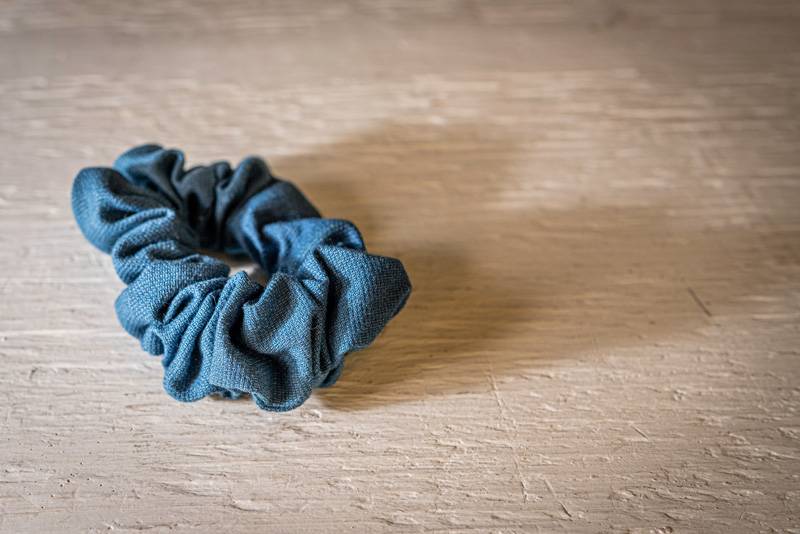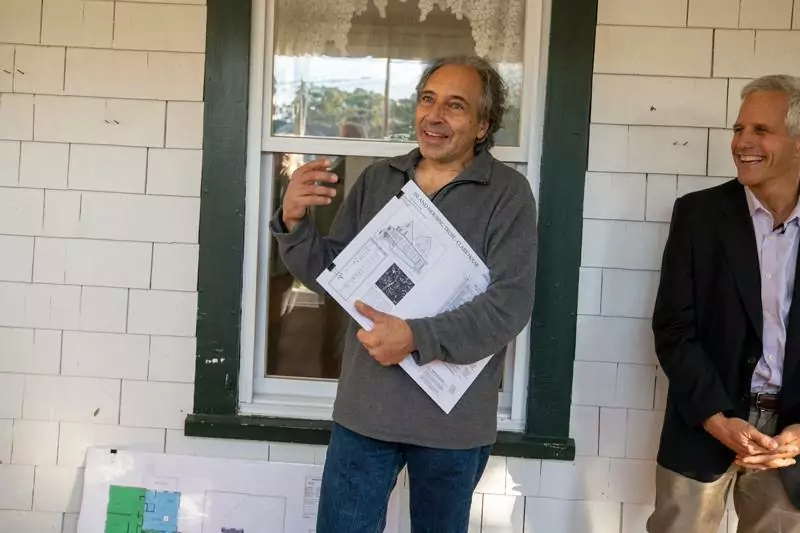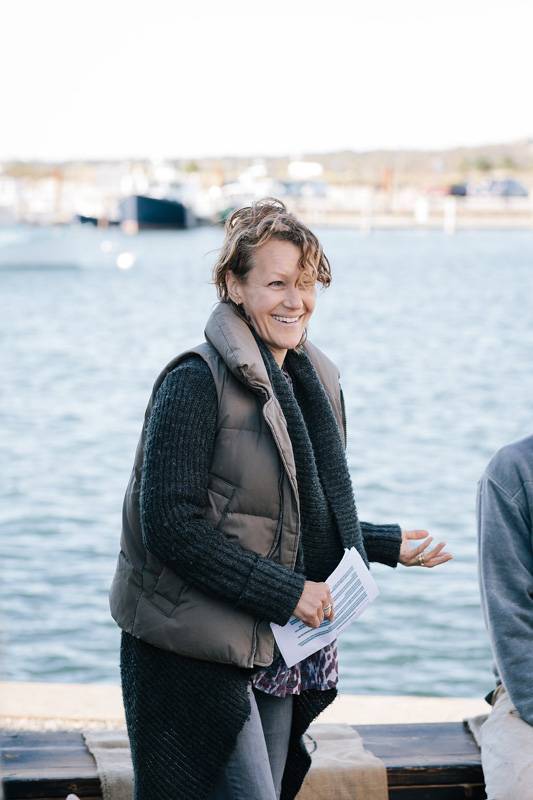There’s a lot of buzz around the phrase “green economy,” but what, exactly, is it?
Angela Sison couldn’t have opened Conrado, her shop on Main Street in Vineyard Haven, at a worse time. There was a pandemic raging across the globe, and restrictions relegated many of us to our homes. Her stock largely consisted of dresses — and who wears a dress to watch Netflix or attend an online meeting? And then five other shops that carried her clothing closed their doors.
But Sison, who grew up in the Philippines watching her mother manage her garment factory, was undaunted. She created a few loungewear items better suited for pandemic life. She began making masks and donating them to hospital staff and other frontline workers. And people bought her items anyway, she said, suggesting that the pandemic reminded all of us that we needed to support our local businesses or risk losing them entirely.
But this isn’t just a story about small local businesses, it’s about ones built on sustainability. It’s about what, exactly, a green economy is. It’s about how we can grow an economy that treats both the planet and its people with dignity and respect.
Sison, for instance, makes her designs from what’s called deadstock in the garment business — the excess, unused fabric from a large contract that typically goes to waste. This summer, she’s hired two local students to help them learn the trade. She continues to use her mother’s factory in the Philippines, where they ensure safe working conditions and fair pay. And while she loves fashion, Sison is committed to creating items that last, so that people can purchase less and wear them often.
What Sison is doing isn’t so much new as newly appreciated. What she is doing is participating in a green economy.



When we hear the term green economy, a lot of us think of solar panels and wind turbines, perhaps electric vehicles. And all of those innovations certainly fit. Indeed, two of the three fastest growing professions in the U.S. are solar and wind technicians (the third, for the record, is nursing).
Vineyard Wind, Massachusetts House Rep. Dylan Fernandes told Bluedot Living in a statement, is “a great opportunity to create new, well-paid jobs for Island residents.”
Liz Durkee, climate planner for the Martha’s Vineyard Commission, (and Bluedot’s “Local Hero” for this issue, see page 64) agrees that the wind farm jobs are a boon for the Island — early estimates are that roughly 500 union jobs will go to Cape Cod, New Bedford, and Martha’s Vineyard. “What is going to happen as we get more involved in climate adaptation and mitigation is more green jobs,” she says. But a green economy extends, she says, to “heat pump installations, electric vehicle maintenance, salt-marsh restoration, living shorelines.” The key is ensuring a workforce that’s educated in and trained for this growing economy, which is why an important part of Durkee’s work is in education. “We’re going to be talking more with representatives from the business community,” she says, “about things like going to the high school and talking to the vocational ed people … so that students can have skills that are going to be marketable when they get out of high school.” Adult and Community Education (ACE MV) offers courses at various times, including wind technician.
Gina McCarthy, President Biden’s White House national climate advisor, calls it “a pivotal moment,” telling Grist CEO Brady Piñero Walkinshaw in a March 2021 interview that this is “an extraordinary opportunity to create a better life for our children… Not just about climate, but human beings who don’t live as well … because they’ve been facing systemic challenges for years.”
What McCarthy references is that a green economy can’t simply be about climate-related jobs per se; those jobs must be secure and pay a living wage. And more than that, a green economy must include climate justice — creating opportunity for those on the frontlines of climate change whose communities are or will be most affected. It’s about infrastructure that dovetails with climate goals. It’s about affordable, sustainable housing. Solar panels and wind turbines and EVs? Sure. But that’s just the beginning.
“What is going to happen as we get more involved in climate adaptation and mitigation is more green jobs,” says M.V. Commission’s climate change planner, Liz Durkee, “including heat pump installations, electric vehicle maintenance, salt- marsh restoration, living shorelines.”
Green + blue + creative = Vineyard economy
Liz Durkee is clear-eyed about the challenges that Martha’s Vineyard faces as the effects of the climate crisis hit close to home. “Change is coming, and we can’t stop it,” she says. “So we have to embrace it, and look at ways to improve the situation.”
Durkee considers a green economy as part of a larger Vineyard economy, which includes the blue economy — people working in the businesses related to the ocean and coasts, and the creative economy — artists of all kinds.
Nevette Previd, founder of Farm. Field. Sea., which organizes and promotes events related to the Island’s food culture, has given this considerable thought. “I worked on the Living Local harvest festival for years,” she says, “and we would try to sum up ‘living local,’ a snapshot of the Vineyard itself, a literal living local economy. You need affordable housing, you need a fair living wage, you need accessible food.” Previd sees the blue economy as separate from the green, but with a similar intention. “Blue economy is focusing on those who make their living on or from the sea. If we do it right, there’s a lot of opportunities for us as an Island to build up communities who are slowly, because of [climate] reasons, being compromised, like fishermen or oyster farmers, to give them more of a platform, more of a voice, to help them help themselves.”
A (solar) roof of one’s own

To Derrill Bazzy, the purpose of a green economy is simple. “It’s people,” says the project development manager for Island Housing Trust. Putting those people in affordable housing is what Bazzy does. But not just any housing. Sustainability is key to Bazzy and those involved with Island Housing Trust. Given incentives for nonprofits to build with an eye to environmental responsibility, it’s just as affordable, says Bazzy, “and [President] Biden’s promising even more in that direction.” Right now, Bazzy is working with Resonant Energy, a employee-owned certified B Corporation (a certification that requires adherence to social and environmental responsibility). Resonant Energy contracted with South Mountain to put solar on a project at Scott’s Grove in West Tisbury. But more installations are in the works. “We have a lot of rooftops,” he says. Beyond the positive impact on climate, solar panels mean lower utility bills. “Making it work for people to be able to stay [on the Vineyard] can also be regenerative for really good housing,” says Bazzy.
But while respect for the environment is vital to a green economy, Bazzy insists that people remain the cornerstone. “Most of us agree that conservation is a good thing,” he says. But “housing is people conservation. Why do land conservation if you’re not going to do people conservation?”
Gina McCarthy concurs, noting that “housing is a climate issue too,” alongside good-paying, unionized jobs, transportation (hello, VTA’s electric buses!), green spaces, tree planting, and air quality …
Reimagining the economy

“Food, too,” says Liz Durkee. “The more food we grow on our own, the more secure we are.” She points to the growing role aquaculture can play in an Island context: “We have to look at the big picture and see how it all relates together.”
Durkee sees a Vineyard economy through the lens of what’s possible. “What we can do is take these [climate] challenges and turn them into opportunities,” she says. “We can make things even, in some ways, better than they were before.”
Which is precisely how Angela Sison sees Conrado’s mission. When someone walks into her store, she says, she always talks to them about how her clothes are made. “And right away, I see a shift in their faces. They’re not just looking at pretty items … they have a story to them.”
Previd sums it up: “I guess the green economy is basically saying all humans should have the possibility to live the best that they can live.”
Putting a price on nature
While the romantics among us might blanch at the notion of putting a price on, say, a sunset, or a snow-capped mountain, monetizing the natural world is likely as old as money itself.
Conservation is sometimes perceived as getting in the way of prospering off nature, rather than recognizing that the preserved natural world can dispense financial benefits that are hard to quantify. For instance, regenerating and protecting the mangroves of Colombia ensure the health of local fisheries, reduce the likelihood of flooding, and sequester so much carbon their existence helps the country get closer to its Paris climate agreement goals. While it might be noble to protect nature for its own sake, for the awe it inspires, the Natural Capital Project at Stanford operates with the belief that environmental preservation is also to serve us. Not as radical as it sounds when one considers that we, too, are a species, though arguably an invasive one.
“Expressing some of nature’s values in monetary terms can help make clearer what’s at stake from losing or degrading [it],” says Lisa Mandle, lead scientist with the Natural Capital Project, which aims to motivate people to preserve the natural world. She points to the time in the 1990s when New York City considered installing a water filtration plant, but discovered it was cheaper to invest in upstream communities to conserve the Catskills watershed, which provided most of the city’s drinking water.
Putting an actual figure on the natural world isn’t saying that number reflects the full value, explains Mandle, noting that spiritual and cultural values assigned to the natural world aren’t quantifiable: “But by adding that additional monetary benefit to the calculation where it might otherwise have been assumed to be zero, we can show a more comprehensive picture of what’s at stake if we choose not to preserve nature.” Find out more at naturalcapitalproject.org.

